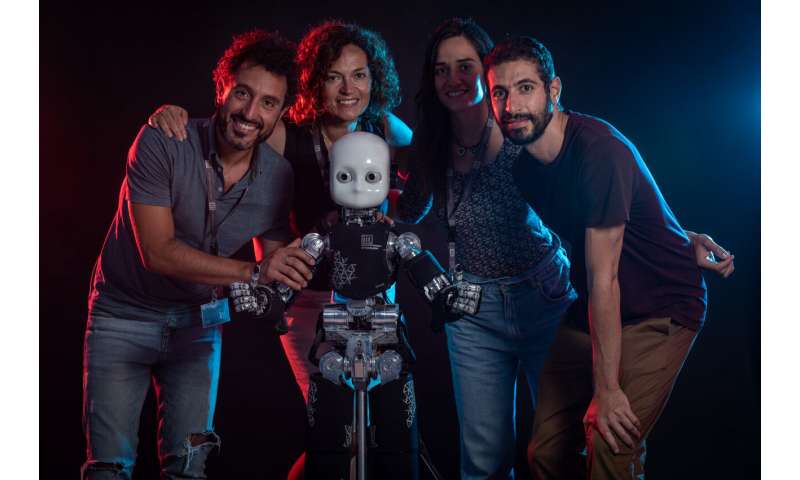Mahindra Lifespaces unveils India’s first home buying experience on the Metaverse
SOURCE: HTTPS://INDIATECHNOLOGYNEWS.IN/
OCT 31, 2023
In competition with humanoid robots, humans delay their decisions when robots see them
SOURCE: FLORIDANEWSTIMES.COM
SEP 01, 2021

Science robotics). Humans are playing against robots while her brain activity is being measured by electroencephalogram (EEG). Credit: IIT-Istituto Italiano di Tecnologia “width =” 800 “height =” 530 “”/>
Belkaid et al. Illustrations of humans and humanoid robots engaged in competitive games, as reported in. “Human gaze with robots affects human neural activity and slows down the decision-making process.”Science robotics). Humans are playing against robots while her brain activity is being measured by electroencephalogram (EEG). Credit: IIT-Istituto Italiano di Tecnologia
Gaze is a very powerful and important signal between human-to-human communication and interaction, communicating intent and informing others of their decisions. What happens when a robot and a human interact while looking at each other? Researchers at IIT-Istituto Italiano di Tecnologia (Italian Institute of Technology) investigated whether the gaze of humanoid robots influences the way people reason in the context of social decision-making. They found that mutual gaze with robots affects human neural activity, influences the decision-making process, and especially delays them. In this way, the robot’s line of sight makes humans perceive it as a social signal. These findings have a strong impact on the circumstances in which humanoids may find applications such as colleagues, clinical support, and domestic assistants.
This project, called InStance, addresses the question of when and under what conditions people treat robots as intentional beings.That is, to explain and interpret robotBehavior, people refer to mental states such as beliefs and desires.
The authors of the research papers are Marwen Belkaid, Kyveli Kompatsiari, Davide de Tommaso, Ingrid Zablith, and Agnieszka Wykowska.
In most everyday situations, Human brain You need to be involved not only in decision making, but also in predicting and predicting the behavior of others. In such situations, gaze can be very informative about the intentions, goals, and future decisions of others. Humans pay attention to the eyes of others, and when someone looks at them or looks at a particular event or place in the environment, the brain reacts very strongly. Researchers have investigated this type of interaction with robots.

The authors of the research paper are Marwen Belkaid, Kyveli Kompatsiari, Davide de Tommaso, Ingrid Zablith, and Agnieszka Wykowska (team leader) in IIT’s laboratory “Social Cognition in Human-Robot Interactions”. Credit: IIT-Istituto Italiano di Tecnologia
“Robots will be more and more present in our daily lives,” said Agnieszka Wykowska, Principal Investigator and Lead Author of the Treatise at IIT. “That’s why it’s important to understand not only the technical aspects of robot design, but also the human aspects of human-robot interactions. Specifically, how the human brain transmits action signals by robots. It is important to understand what to do with it. ”
Wykowska and her research group asked a group of 40 participants to play a strategy game (chicken game) on the robot iCub, measuring their behavior and neural activity. The latter used electroencephalography (EEG). The game is strategic, with two drivers in a simulated car moving towards each other on a collision course, the result of which depends on whether the player succumbs or keeps going straight.
Researchers have found that participants are slow to respond when iCub establishes mutual gaze decision Create in relation to the avoided line of sight. Delayed response may suggest that mutual gaze is associated with higher cognitive effort. For example, draw more reasoning about iCub choices or increase the degree of suppression of gaze stimuli that may be unrelated to the task.
Credit: IIT-Istituto Italiano di Tecnologia
“Think of playing poker with a robot. When the robot is looking at you when you need to decide what to do next, it makes a decision compared to when the robot is looking away. .. Your brain also needs to adopt a laborious and costly process to try to “ignore” the robot’s gaze, “says Wykowska.
These results show that the robot Line of sight It “hijacks” the “social cognition” mechanism of the human brain, causing the robot to react to the robot as if it were a social agent. In this sense, being “social” for robots is not always beneficial to humans, even if the interactions are fun and engaging, and can hinder decision-making performance and speed.
Wykowska and her research group hope that these findings will help robotics engineers design robots that exhibit the most suitable behavior in the context of a particular application. Humanoids with social behavior may help support elderly and childcare care that is part of the experimental treatment in the treatment of autism, as in the case of iCub robots. On the other hand, when you need to focus on a task, such as factory setup or air traffic control, the presence of robots with social signals can be distracting.
LATEST NEWS
Augmented Reality
Hi-tech smart glasses connecting rural and remote aged care residents to clinicians
NOV 20, 2023
WHAT'S TRENDING


Data Science
5 Imaginative Data Science Projects That Can Make Your Portfolio Stand Out
OCT 05, 2022

SOURCE: HTTPS://INDIATECHNOLOGYNEWS.IN/
OCT 31, 2023
SOURCE: HTTPS://FINANCE.YAHOO.COM/
SEP 28, 2023
SOURCE: HTTPS://MEDIABRIEF.COM/
SEP 22, 2023
SOURCE: HTTPS://WWW.BUSINESS-STANDARD.COM/INDIA-NEWS/METAVERSE-WEB3-MARKET-TO-GROW-40-ANNUALLY-TO-REACH-200-BN-BY-2035-123060200394_1.HTML
JUN 28, 2023
SOURCE: HTTPS://WWW.WIRED.COM/STORY/WHAT-IS-THE-METAVERSE/
JUN 20, 2023